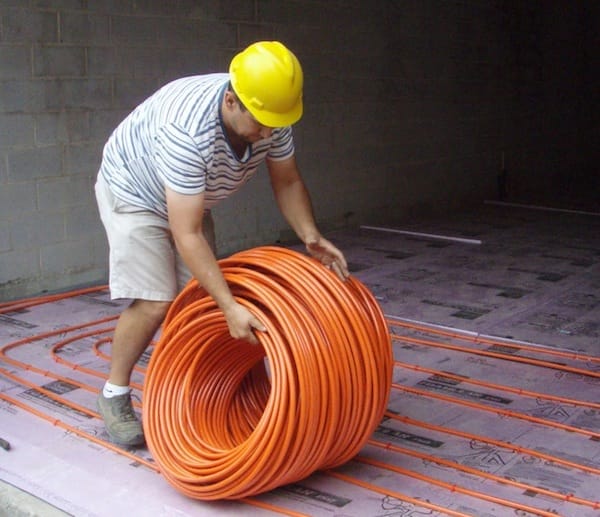Respect. That’s the first thing that came to my mind as I walked onto the jobsite. Man, it was cold that mid-January day — 15 F temps and my feet were getting cold just minutes into touring the Andersonville (north of Chicago) new construction site, which once was the site of a candy factory. The “shell” of the home was constructed but not much else was ready — from electrical to plumbing to heating. As I found myself bitching under my breath about how cold it was, Dan Beniuc, owner of Hydronics, Inc., Niles, Ill., and his crew were prepping the home for a geothermal heating and hydronic system. To them, it was another day on the job, no matter how cold it was. Hydronics Inc., which specializes in work involving renewable and energy efficiency systems based on, well, hydronics, had multiple jobs in the area, and every job became a learning experience for the next. “We learn from what we’ve done in the past and we make it better,” says Beniuc.
I met Beniuc and good friend Piotr Zelasko, part of the Design+Build Support Group at Able Distributors, Chicago, to tour the home. Able Distributors Design+Build Sales team relishes the opportunities where its collective knowledge of products and applications can add to the skills of its customers, mechanical contractors, leading to satisfied homeowners. Zelasko points out that Able takes the time to draw up detailed quotations and act as a resource for the contractor on the jobsite. “Our allegiance is to the contractor; we try to make their jobs easier and we want them to be our partners,” says Zelasko, who was making due despite a broken right foot.
The two-story, 6,000-sq.-ft. single-family home features a comfort system based on a hybrid approach, with Bosch Thermotechnology water-to-water heat pumps as a primary source of energy for hydronic heating — with two water-to-water heat pumps for chilled and hot water — and Bosch air handlers for secondary stage forced air space heating and cooling and IAQ, including ERV and steam humidification. The nearly 6000 sq. ft. of living space on three levels features multi-zone hydronic radiant floors, 600 sq. ft. of hydronic radiantly heated detached garage (serving as a music room with provisions to receive additional heating and cooling from Fujitsu ductless mini-split air source heat pump), 800 sq. ft. of exterior surfaces provisioned with a hydronic snow and ice melting system. Beniuc chose (concrete) underslab Watts Radiant PEX-AL tubing with Caleffi S1 manifolds.
The hydronic heating system is designed to accept supplemental energy from a gas fired condensing, modulating boiler from NTI TFT, also responsible for DHW production via indirectly heated storage cylinder. Injection of boiler energy into geo-exchange powered hydronic system is accomplished automatically based on the features from a NTI TFT boiler controller. Upon increase in energy demand, the boiler controller responds to drop in flow temperature, and activates to inject energy as needed to maintain the flow temperature at the desired level. Space temperature control system to be based on a combination of tekmar and Honeywell controls.
Ground coupled heat exchange is based on a Rygan engineered solution — consisting of two 400-ft. vertical boreholes in the backyard — with coaxial HPGX wells. This particular drilling offered far more capacity with up to five tons per borehole and an overall 10-ton capacity. The drilling was sub-contracted out to Great Lakes Geothermal, West Chicago, Ill. To drill in extremely adverse conditions, such as on cold weather days is not ideal, yet can be done at 15 F or above, and proved to be no problem for Great Lakes. We were certainly toeing the temperature line that day.
Lateral mains extend to mechanical rooms where the geothermal flow is distributed via five Wilo Stratos ECM pumps, with variable flow rate depending on activity of individual heat pumps units. Wilo constant speed pumps were also used.
Radiant Row Homes
The second part of my ride along took us to newly constructed row homes in the general vicinity called the Backyard Homes project. The first floors of all of these 23 units were radiantly heated — mandatory because of the venting in the ceiling, with forced air on the second floors. Acting in the best interest of the investors — due to budgetary restrictions — Beniuc chose 40-gallon Rheem water heaters were used for the first floor radiant and 40-gallon Bradford White Defender Series water heaters were used for all domestic hot water. Beniuc chose underslab Watts Radiant PEX-AL as the tubing and Zurn manifolds were selected here. Caleffi air eliminators and fill valves were used.

These upscale row homes (or condos) feature first floor radiant heating and second floor forced air heating.

The radiant heat is produced from the 40-gallon Rheem water heater and the DHW was generated from the 40-gallon Bradford White unit.

The row homes’ mechanical rooms also featured beautiful artwork in design installation, and included Taco relays, Zurn manifolds, Wilo pumps and Caleffi air eliminators and fill valves.










Join the conversation: